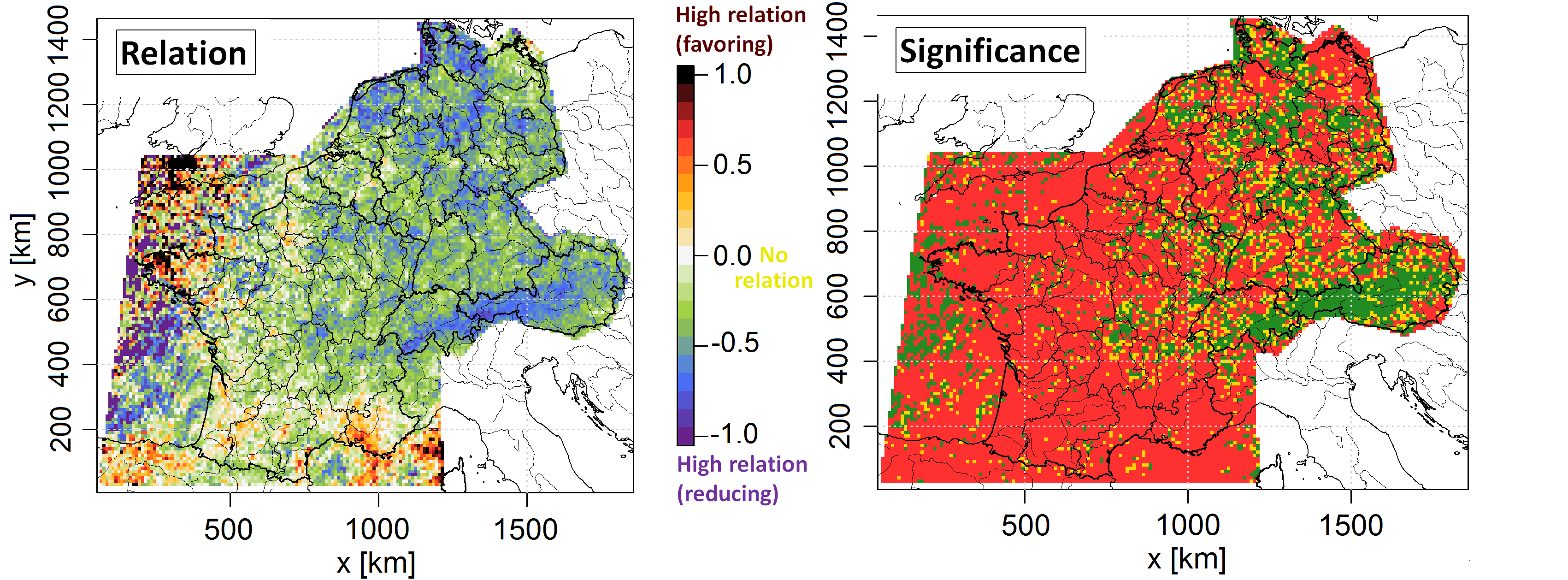Long-term Variability and serial Clustering of Severe Thunderstorms in a changing climate (VarCluST)
- Contact:
M.Sc. M. Augenstein, Dr. S. Mohr, Prof. Dr. M. Kunz
- Funding:
BMBF (ClimXtreme)
The project Long-term Variability and serial Clustering of Severe Thunderstorms in a changing climate (VarCluST) is a sub-project of the BMBF joint project ClimXtreme (Climate Change and Extreme Events). ClimXtreme is a 3-year project funded by the German Ministry of Education and Research (BMBF). Within the Module A Physics and Processes, the overall aims are to achieving a comprehensive view of meteorological extremes in Europe under climate change with a focus on the period from the 20th and 21st century. In particular, the project focusses on an improved assessment of extreme weather events in Central Europe in a changing climate. The assessment comprises changes in frequency, severity, spatial distribution and duration of past and future storms, high precipitation events, summer dry/hot periods and convective hazards. The aim is to understand and quantify the relevant causal mechanisms, and to validate these mechanisms in climate models in order to reduce uncertainty in future projections.
The aim of VarCluST is to link severe convective storms (SCS) in Europe with large-scale atmospheric processes and to investigate the influence of these processes on the annual variability of SCS both in the past and in the future. Furthermore, this project investigates how large-scale mechanisms determine clusters of SCS on scales of several days to weeks (referred to as serial clustering). Knowledge on these mechanisms is still insufficient, but a prerequisite for estimating robust statements about long-term changes and trends in the SCS frequency.
VarCluST intend to answer two major scientific questions:
1. Which large-scale processes (e.g., teleconnection patterns or certain weather types such as atmospheric blocking) have an influence on the high observed annual variability of SCS in the past and which changes in thunderstorm frequency and relevant processes can be expected in the future?
2. Which atmospheric mechanisms influence the increased occurrence of SCS within a few days up to several weeks (serial clustering)?
First, the project will generate an event set of SCS based on lightning and overshooting tops (OT) data. The latter describes the convective "overshooting" of thunderstorm clouds into the tropopause (approx. 12 km) due to the strong updrafts in such systems. These OT can be detected very well by satellites. Based on this event data set, an index for SCS will be developed by a suitable combination of different meteorological parameters relevant for thunderstorm formation, which can be transferred to regional climate models, since currently even high-resolved climate models are not able to reliably represent SCS. This index will then be applied to a reanalysis data allowing a statistical analysis of longer time series than based on time series of direct observations (lightning/satellite; 40 instead of 20 years). Long time series are important to statistically investigate relationships to low-frequency variability modes of the climate system (e.g., teleconnection patterns), which are relevant for the annual or multi-year variability of convective activity. Past work at KIT has already shown that certain teleconnection pattern can influence the occurrence of thunderstorm activity in certain regions of Europe. For example, Piper et al. (2019) observed that a significant reduction of thunderstorm activity can be expected in many of the investigated European regions during the negative phases of the East Atlantic Oscillation (EA; see Fig.).
For the second question, specific weather conditions, which are responsible for serial clustering of the SCS, are statistically investigated. For example, Mohr et al. (2019) already observed a relation between thunderstorms and atmospheric blocking over the Baltic Sea. Blocking situations have also shown that they can be responsible for the unusual accumulation of thunderstorm events over several weeks (Piper et al., 2016; Mohr et al., 2020). Further large-scale factors should to be determined here.
Finally, the obtained knowledge will be transferred to an ensemble of regional climate models to estimate the probability and persistence of SCS and SCS-related large-scale processes in future decades.
References:
Mohr, S., Wandel, J., Lenggenhager, S., and Martius, O. (2019): Relationship between atmospheric blocking and warm season thunderstorms over western and central Europe, Q. J. R. Meteorol. Soc., 145, 3040–3056, https://doi.org/10.1002/qj.3603.
Mohr, S., Wilhelm, J., Wandel, J., Kunz, M., Portmann, R., Punge, H. J., Schmidberger, M., and Grams, C. M. (2020): The role of large-scale dynamics in an exceptional sequence of severe thunderstorms in Europe May/June 2018, Weather Clim. Dynam. Discuss., https://doi.org/10.5194/wcd-2020-1.
Piper, D., Kunz, M., Ehmele, F., Mohr, S., Mühr, B., Kron, A., and Daniell, J. (2016): Exceptional sequence of severe thunderstorms and related flash floods in May and June 2016 in Germany. Part I: Meteorological background, Nat. Hazards Earth Syst. Sci., 16, 2835–2850, https://doi.org/10.5194/nhess-16-2835-2016.
Piper, D. A., Kunz, M., Allen, J. T., and Mohr, S. (2019): Investigation of the temporal variability of thunderstorms in Central and Western Europe and the relation to large-scale flow and teleconnection patterns, Q. J. R. Meteorol. Soc., 145, 3644–3666, https://doi.org/10.1002/qj.3647.

Fig.: Relative deviation of the monthly number of thunderstorm days between 2001 and 2014 during the negative phase of the East Atlanic Pattern (left) and the associated statistical significance (right, bootstrap tests with the level of Si = 95% in green, Si = 90% in yellow and Si < 90% in red; Piper et al., 2019).
